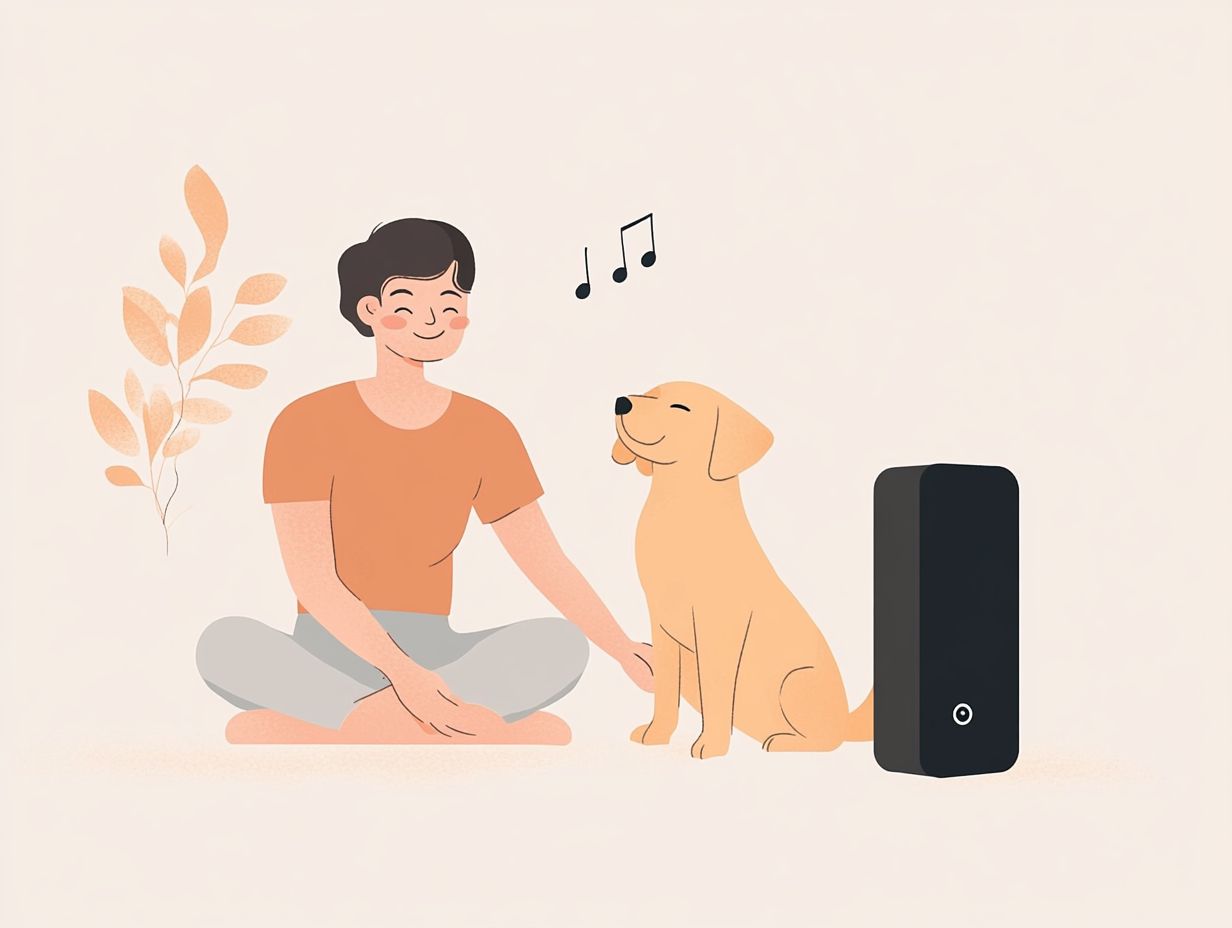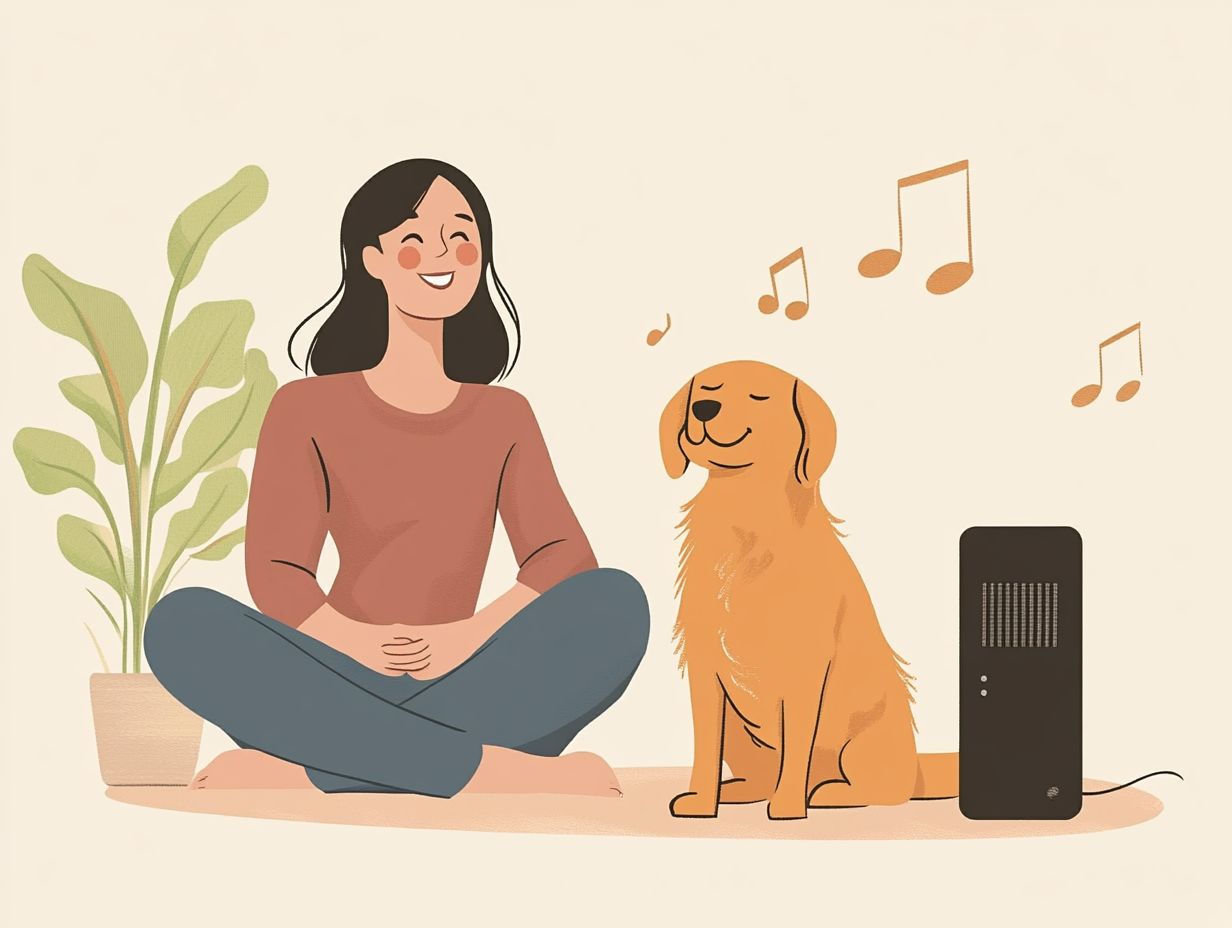Using Music to Calm Anxious Pets During Training
Did you know that music can calm your pets during training? Music isn t just a human experience; it has a remarkable impact on your furry companions as well. Many pet owners are uncovering the soothing effects of music on their animals, particularly during training sessions.
This article delves into how various genres of music can alleviate anxiety and stress while enhancing focus and behavior in pets. It also guides you on selecting the perfect tracks and effectively integrating music into your dog training regimen. Additionally, it explores strategies to create a tranquil environment for your cherished pets.
Discover the harmonious benefits that music therapy can bring to your pet training journey.
Contents
- Key Takeaways:
- The Impact of Music on Pets
- Benefits of Using Music During Training
- Choosing the Right Music for Your Pet
- How to Incorporate Music into Training
- Other Calming Techniques for Pets
- Frequently Asked Questions
- How can I use music to calm my anxious pet during training sessions?
- Why is music an effective tool for calming anxious pets during training?
- What types of music should I use to calm my anxious pet during training?
- Can I use any music to calm my anxious pet during training?
- How can I incorporate music into my pet’s training routine?
- Are there any other benefits to using music to calm anxious pets during training?
Key Takeaways:

- Music can have a calming effect on pets during training by reducing anxiety and improving focus and behavior.
- When choosing music for your pet, consider factors like tempo, volume, and genre to create a soothing environment.
- Incorporate music by creating pet playlists with specific songs for different commands or by playing soothing melodies in the background during sessions.
The Impact of Music on Pets
The impact of music on pets, particularly dogs, is a fascinating area of research. Various genres think classical music, soft rock, reggae, and even soothing sound frequencies can significantly enhance their emotional well-being.
Experts like Dr. Deborah Wells and Dr. Lori Kogan have discovered that specific types of music reduce stress and anxiety in dogs. This effect is especially noticeable during nerve-wracking veterinary visits or when dogs face separation anxiety, often exacerbated by noise pollution.
By curating pet playlists tailored to your dog s preferences, you can boost these benefits by using music as a tool for sound therapy. This can improve your dog’s overall emotional well-being.
Understanding How Music Affects Animals
Understanding how music impacts animals, especially dogs, requires exploring their unique sound perception abilities and the study of how animals hear and respond to sounds.
Dogs boast an impressive hearing range, capable of detecting sounds at frequencies as high as 65,000 Hz far beyond the human limit of 20,000 Hz. This heightened sensitivity means that what may register as faint noise to you can be an overwhelming or even distressing experience for your dog.
Noise pollution can significantly affect your dog s well-being, leading to stress and anxiety. This highlights the importance of creating a sound-friendly environment for your dog.
Benefits of Using Music During Training
The benefits of incorporating music into your dog training sessions are truly remarkable. Not only does it create a calming atmosphere, but it also enhances focus and minimizes anxiety, paving the way for more effective learning.
You will discover that various genres, from classical music to soft rock and even reggae, can significantly elevate the training experience, making it enjoyable for both you and your furry companion.
Behavioral studies suggest that introducing soothing melodies during training can lead to better command retention and improved behavioral outcomes in dogs. This is particularly true when exploring the impact of different genres like reggae and soft rock, transforming your sessions into a harmonious blend of education and enjoyment.
Reducing Anxiety and Stress
Reducing anxiety and stress in your dog through music is backed by research. Calming melodies create a tranquil atmosphere for your pet. Music therapy, endorsed by experts like Dr. Susan Wagner, is especially effective in soothing anxiety during stressful moments like veterinary visits or bouts of separation anxiety.
Various types of calming music including classical compositions, specially curated dog playlists, and nature sounds can yield impressive results. These genres lower heart rates and help your dog feel more at ease, echoing studies that emphasize the health benefits of soothing tunes.
For example, a study from the University of Glasgow highlighted that classical music effectively reduces stress levels in dogs. Many pet owners report success using ambient sounds that mimic nature. Recognizing your dog’s unique preferences is crucial; personalizing their auditory experience can enhance its calming effects.
Improving Focus and Behavior

Improving your dog s focus and behavior can be remarkably enhanced through the power of music. Certain genres have proven effective in maintaining concentration during training sessions.
Numerous studies support this intriguing phenomenon. Classical music lowers anxiety levels, creating a serene environment that fosters learning. Conversely, upbeat styles, like reggae and soft rock, generate an energetic ambiance, encouraging physical activity and engagement perfect for lively training exercises.
Incorporating these musical styles into your daily interactions can stimulate your dog’s thinking skills while minimizing disruptive behaviors. This approach paves the way for a more harmonious relationship between you and your beloved pet.
Choosing the Right Music for Your Pet
Finding the right music for your pet can be a fun journey! It requires understanding their preferences and the calming effects of different sound frequencies. This approach gives your pet a special listening experience that can boost their happiness.
Tools like iCalmPet, Pet Acoustics, and playlists on platforms such as Spotify or Through a Dog’s Ear help you curate the perfect auditory environment that harmonizes with your dog’s unique tastes.
Factors to Consider
When selecting music for dogs, consider factors like genre, tempo, and sound frequencies that contribute to stress relief and create a calming atmosphere.
Not all dogs respond the same way to music. Some may find solace in soothing classical melodies, while others might relax better with soft rock or ambient sounds. The tempo plays a significant role; slower beats promote relaxation, while faster tempos might induce excitement.
Individual characteristics like breed, age, and prior experiences influence how effectively music alleviates stress for your dog. Recognizing these nuances allows you to curate tailored playlists, enhancing their overall well-being.
How to Incorporate Music into Training
Incorporating music into dog training elevates the experience, creating a more enjoyable and effective learning environment for both you and your dog. This is especially helpful for reducing separation anxiety.
Playing calming music during training sessions can work wonders. It helps alleviate anxiety, enhances focus, and enriches the overall training journey.
Tips and Techniques for Using Music
Discover how music can transform your dog’s training experience! Utilizing effective training tips and techniques with music can truly change how your dog responds during training sessions. This significantly enhances their learning experience, especially with tailored pet playlists.
By carefully considering factors like timing, volume, and musical genres, you can craft an optimal auditory environment that complements your traditional training methods. For example, playing calming tunes during anxious moments can help soothe your dog. On the other hand, upbeat tracks can energize and motivate them during playtime or agility exercises.
Watch the volume closely; keeping it moderate ensures the music serves as rewarding good behavior rather than a distraction. Experimenting with different genres like classical, reggae, or soft rock can lead to delightful discoveries, making it easier for you to find the perfect background music that keeps your dog engaged and focused.
Other Calming Techniques for Pets

Other calming techniques for pets can beautifully complement the use of music. These methods include various relaxation techniques and crafting an environment that integrates soothing melodies, all designed to help your furry friend feel secure and at ease.
Techniques like sound therapy can also help reduce anxiety and foster relaxation in your dog.
Additional Methods for Reducing Anxiety
Additional methods for reducing anxiety in dogs can be quite effective when used alongside music. These techniques address both behavioral and environmental factors, such as noise pollution.
Creating a serene environment is essential. Think soft lighting, cozy bedding, and a quiet space free from distractions. You might also consider behavioral training, using positive methods to teach your dog how to respond calmly to triggers that usually spark anxiety.
Incorporating gentle interactions, distraction toys, and even pheromone diffusers devices that release calming scents can do wonders in enhancing the overall calming atmosphere.
Don t underestimate the power of regular exercise, either. It helps to burn off excess energy and stress, promoting a more relaxed demeanor overall. By blending these diverse strategies, you can significantly elevate your dog’s well-being.
The Power of Music in Pet Training
The power of music in pet training is gaining recognition. It not only cultivates a calming atmosphere but also enhances the overall effectiveness of learning and behavioral correction.
When you thoughtfully integrate beneficial melodies into your training sessions, you can significantly ease anxiety in your dog. This makes them more receptive to your commands and guidance. Research indicates that certain frequencies and rhythms promote relaxation, fostering positive associations with training experiences.
This therapeutic use of sound not only helps manage stress but also stimulates cognitive processes, leading to improved focus and quicker learning.
As a pet owner, you ll find that incorporating music into your training routines creates an environment where your dog feels safe and secure. This fosters better communication and strengthens your bond, turning training sessions into enjoyable and productive experiences.
Frequently Asked Questions
How can I use music to calm my anxious pet during training sessions?
Here’s how to use music to soothe your anxious pet during training: Start by selecting calming music with a slow tempo and low volume. Play the music before and during the training session to create a peaceful environment for your pet. Additionally, consider using scent training to calm anxious pets as another effective method. You can also try playing music specifically designed for pets, such as classical music composed for animals.
Don t wait! Start using music today to help your dog relax.
Why is music an effective tool for calming anxious pets during training?

Music calms both humans and animals. It reduces stress and creates relaxation, helping pets focus during training, especially when considering best practices for pet anxiety training.
What types of music should I use to calm my anxious pet during training?
Choose songs with a slow tempo (the speed of the music) and low volume. Avoid music that changes suddenly, as it can startle your pet.
Can I use any music to calm my anxious pet during training?
No, some music can worsen anxiety. Stay away from lyrics and high-energy genres like heavy metal or rock.
How can I incorporate music into my pet’s training routine?
Play music before and during training to create calmness. You can also have it in the background during grooming or playtime.
Are there any other benefits to using music to calm anxious pets during training?
Music not only reduces stress but can also brighten your pet’s mood. It makes training enjoyable for both of you. Listening to calming music can soothe you as well, creating a peaceful environment.






